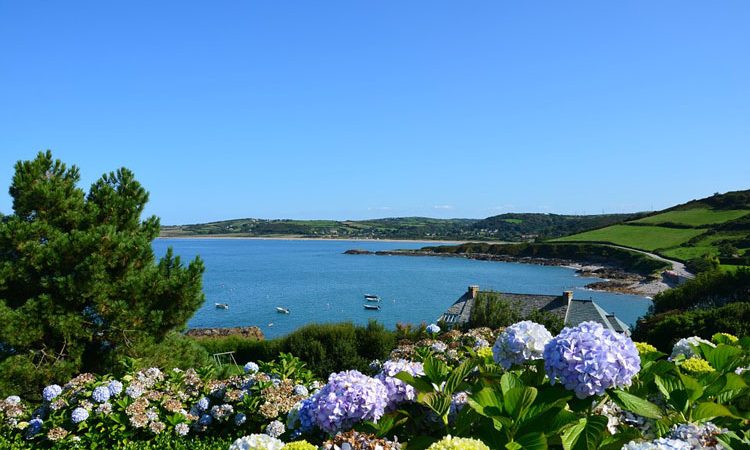
The almost constant enemies of seaside gardening are wind, salt and sand. Frost, however, is neither so prolonged nor so severe on the coast as it is inland, and seaside gardeners have been able to grow many frost-tender plants in the milder climate of their coastal gardens.
Inland gardeners have little idea how powerful is the effect of coastal wind on the growth of plants, and because none or few trees or buildings present a barrier to soften its effect during windy conditions the wind sweeps continuously in from the sea. Wind stunts and it deforms—one has only to observe the fantastic shapes of trees close to the sea to realise this.
Salt can kill outright. It is carried in the spray, and when the wind catches it, it is often deposited many hundreds of yards inland. Few plants are able to withstand the continual battering of sea wind heavily charged with salt, which is heavily scorching to plants.
Sand-blast is often too lightly regarded by newcomers to the coast, though its effect can be quite as damaging as salt’s. Seashore gardens suffer badly from its searing effect when the wind picks up the sand from a nearby beach. Small seedlings are killed and adult foliage is bruised and blackened.
The only answer to the problem of wind, salt and sand is shelter, and it is not possible to create a worthwhile garden in extremely exposed positions on the coast without it, though where a garden has protection a very wide range of plants will thrive which would not succeed in frosty gardens inland. Many plants will grow only when given adequate shelter at the outset, and the planting of newly-made gardens exposed to the full ravages of gales off the sea is rarely successful without the aid of some artificial wind-screen.
Planting of shelter belts of trees on a large scale benefits from an open fence of a two-bar wooden structure interwoven with foliage of gorse or spruce. For small gardens there is nothing better than a fence of wooden laths, 2.5cm (1in) wide with spaces of similar size, set vertically on a stout wooden framework and posts at either end for driving into the ground. Avoid a solid barricade such as a wall, which causes wind-turbulence on the lee side, since the aim is always to filter the wind rather than obstruct it.
Plants which tolerate salt and wind are nowadays very largely selected from those grown in Australia and New Zealand. As a result of long coastlines and varied climatic conditions more successful seaside shrubs have evolved in Australia and New Zealand than in any other part of the world. Shrubs that successfully resist salt-spray are planted facing the sea. These are often equipped with toughened leaves such as are found in the genus Olearia. 0. haastii and 0. albida stand any amount of salty wind. Others have shiny leaf surfaces. Euonymus japonicus and Griselinia littoralis look bright and glossy within a few yards of the sea. Or the leaves of some may be coated with a gummy secretion as in Escallonia macrantha, enabling them to endure a coating of salt. Yet another form of protection is afforded by a multitude of tiny hairs which cover the leaf surfaces of grey-leaved and silver-leaved shrubs. It is a curious fact that most of these are well adapted to withstand the first brunt of a salty blast. Sea buckthorn, Atriplex halimus, Senecio laxifolius and S. monroi are among the best we have for prominent positions in exposed coastal districts. If sand-blast is a menace, tamarisk will grow with its roots in pure sand and is also useful for adding height to rough banks and walls.
Shrubs for milder maritime areas
A. vitifolium
Artemisia canescens
Artemisia stelleriana Azara dentata
Artemisia microphylla
Berberis thunbergii atropurpurea superba
Buddleia auriculata
Buddleia globosa ‘Lemon Ball’
Buddleia nivea
Cassinia fulvida
Cassinia ledifolius
Cassinia leptophylla
Ceanothus ‘Indigo’
Centaurea gymnocarpa Choisya ternata
Cistus crispus ‘Sunset
Cistus ‘Paladin Pat’
Cistus palhinhaii
Clianthus puniceus
Colquhounia vestita
Convolvulus cneorum
Corokia virgata
Crinodendron hookerianum
Desfontainea spinosa
Echium fastuosum
Elaeagnus macrophylla
Embothrium coccineum
Erica alpina
Erica lusitanicus
Escallonia hybrids
Eucalyptus niphophylla
Eupatorium micranthum
Fabiana imbricata
Fremontia californica
Fuchsias (large-flowered)
Halimium alyssoides
Halimiumocymoides
Hoheria glabrata
Hoheria sexstylosa
Hebes (in variety to include H. hulkeana)
Helichrysum petiolatum
Helichrysum plicatum
Hypericum moserianum tricolor
Hypericum `Rowallane’
Jovellana violacea
Lavatera assurgensifolia
Leptospermum scoparium nichollsii
Leptospermum’Red Damask’
Lippia citriodora
Muehlenbeckia complexa
Myrtus luma
Myrtus ugni
Olearia insignis
Phlomis fruticosa
Phormium tenax
Piptanthus laburnifolius
Pittosporum eugenioides
Pittosporum ralphii P. tobira
Polygala myrtifolia
Rosmarinus angustifolius
Rosmarinus ‘Corsican Blue’
Rosmarinus lavendulaceus
Salvia grahamiiinvolucrata bethellii
Sambucus nigra foliis aureus
Senecio cineraria ‘White Diamond
Senecio glastifolius
Senecio huntii
Senecio heritieri
Senecio leucostachys
Senecio rotundifolius
Shrubs for colder maritime areas
Amelanchier canadensis
Atriplex canescens
Atriplex halimus
Baccharis patagonica
Berberis aquifolium
Berberis darwinii
Berberis stenophylla
Berberis thunbergii atropurpurea

